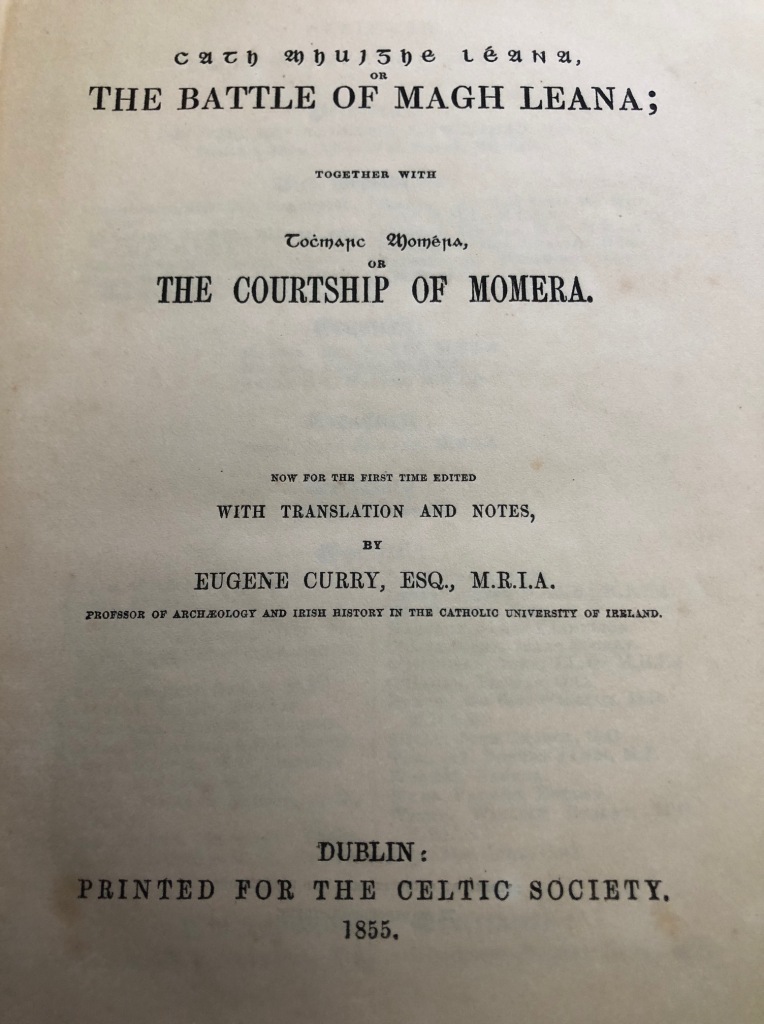Mag Léna is of interest for two events that occurred in the early historic period. The first event is the pseudo historic Battle of Mag Léna. The second event was the significant Synod of Mag Léna and the Letter of Cummain, part of the Irish church row with Rome over the dating of Easter.
Both incidents caused a split in Ireland!
What’s in a name?
Mag Léna is mentioned in logainm.ie as Moylena and places it in the parish of Kilbride, Co. Offaly. Mag or Magh translates as a plain or open country, there is no information provided on the meaning of the word Léna. Unusually, there are no additional references other than the basic location details, also this older relic from the original card index system below. A 13th century manuscript mentions Cath Mhuighe Léana. Magh Léana is mentioned elsewhere. In his Survey Letters we find O’Donovan used a variety of spellings for the name – Moylena, Moyléna, Moyleana, Moleany and Moy-leana.

Logainm index card for Mag Léna.
As usual there are difficulties with the older Gaelic placenames and how they were recorded over time. Today the only memory of the name is in Tullamore, where the Moylena road joins the Clara Road and eventually joins the Rahan Road through Glendaniel.

Moylena, Tullamore. Google maps.
So, where is Mag Léna?
Dábhí Ó Cróinín suggests that it is ‘between Tullamore and Clara’. Alfred P. Smyth in his book on Celtic Leinster describes ‘the monasteries of Rahan, Durrow and Lynally, which are situated in Mag Léna’. Matthew Stout writes that Mag Léna is near Durrow. O’Flaherty’s Ogygia says that ‘Colgan, O’Flaherty and the Annals of Tigernach place the Plain of Moylena in Fera Ceall’ (Fercall).
O’Donovan, writing on 30th December 1837 from Tullamore claims ‘I have discovered the situation and limits of Moylena … I have known these ten years that Moyleana is situated in O’Molloy’s Country of Fera Ceall but I never could find the exact place until I visited the neighbourhood’. Note that O’Donovan had two different spellings of the name on the same page! O’Donovan then lists his references to support his point on the location.
Was Mag Léna a large tuath in north/central Offaly?

The Battle of Mag Léna.
This battle was between Conn Ceadchathach (the Hundred Battles) and Mogh Nuadhat (also known as Eogan or Eogan Mór). The most detailed account is that given by Eugene O’Curry from a 17th century manuscript in his translation called Cath Mhuighe Léana published in 1855, from a copy of a document numbered MS 104 held in the Royal Irish Academy; another vellum copy is in the College of St. Isidore in Rome. The Battle of Mag Léna is also mentioned in the Book of Ballymote, The Book of Lecan, two entries in the Annals of Ulster and in the Book of Leinster. O’Donovan dates the battle to 192 AD.
For most of his reign, Conn was at war with one king or another. This battle was over money. Quoting from O’Flaherty’s Ogygia, O’Donovan adds that Mogh Nuadhat laid claims to revenues coming from Conn’s ports on the eastern coast of Ireland that ‘the harbour that belonged to Conn was infinitely more advantageous with regard to the profits arising from ship duties, fisheries and other commercial emoluments, in consequence of which he demanded half the revenue’.
Before the battle Conn had rested his troops at a camp on the Eiscir Riada and O’Donovan claims that ‘both armies encamp in the plain of Moylena on Ferakell in the King’s County’. O’Donovan then recounts that ‘Eogan (Mogh Nuadhat) crosses the Esker Riada which extended across Moy-Leana, and erects an extensive camp in the north side of it, to wit, on Conn’s portions of Ireland. Conn, being inferior in points of forces, having attacked the improvident enemy very early in the morning, he obtained a signal victory’.
Geoffrey Keating in his History of Ireland writes ‘at the battle of Magh Léna, the two kings divided Ireland into two sections: Leath Mhogha and Leath Chuinn, or, “Mogh’s Half” and “Conn’s Half.” One interpretation of these names is that the Conn refers to the head (ie ceann in Irish) and Mogh refers to a slave (ie mog is the Irish word for a male slave). This division lasted up through the age of Brian Bórúmha (ca. 1,000 CE)’. Keating also says that Conn slew Mogh Nuadhat in his bed.
So, Ireland’s ancient highway, the SlÍ Mór, also known as the Eiscir Riada became the dividing line between two Gaelic kingdoms.
The early part of O’Curry’s book is taken up with the genealogies of both contestants, this ties them back to the Milesian conquest and how that various families fell out and fought with one another.

First page of Cath Mag Léna by O’Curry.
Please note the print font used; some of our older readers may well remember struggling to identify the difference between ‘s’ and the ‘r’ in the last century!

